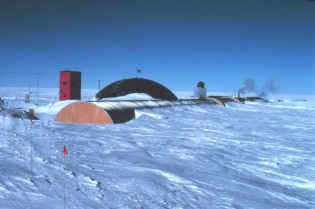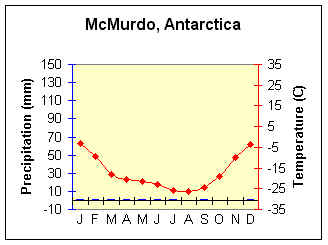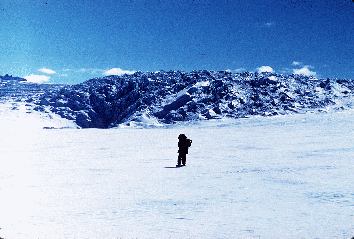Ice Cap Climate
The ice cap climate experiences the coldest temperatures on earth. Located near the poles, this climate experiences bitterly cold temperatures throughout the year, especially during the long polar night. The resulting humidity levels are so low that precipitation amounts may be similar to most deserts. In fact, climatologists have described the ice cap climate as a "polar desert". Geographic DistributionThe ice cap climate is found over the frozen lands of the Arctic and Antarctic. In the Northern Hemisphere, the ice cap climate is found over the interior of Greenland and the permanently frozen portions of the Arctic Ocean and associated islands. In the Southern Hemisphere, the vast glacier covered continent of Antarctica is the largest expanse of ice cap climate. Controlling FactorsThe high latitude location is the primary cause of the extremely cold temperatures and dry conditions. At such a high latitude, sun angle and insolation intensity is low. Additionally, the sun never rises above the horizon during the long months of the "polar night". The sun that does reach the surface is efficiently reflected away by the light colored permanent cover of snow and ice. The ice cap climate is under the year-round influence of the polar high. The high pressure suppresses the needed uplift to cause condensation. The ice cap climate is located in the source region for the extremely cold and dry cA air masses. The ice cap climate experiences invasions of cP, and to a lesser extent, mP air masses. The low saturation point of the cA and cP air masses substantially reduces the chance for precipitation.
Controlling FactorsTemperatureThe ice cap climate experiences the coldest temperatures on Earth. In fact, we could say that the ice cap climate is "summer-less", having no average monthly temperature above freezing. McMurdo Station's annual temperature is a bone-chilling -17o C (1.4oF). The ice cap climate receives meager amounts of solar radiation on an annual basis. This coupled with a highly reflective surface means little absorbed insolation. Though the Sun does remain above the horizon for six months of the year, the low sun angle reduces insolation intensity. During the rest of the year the sun never appears above the horizon and temperatures plummet to the coldest experienced on the planet. PrecipitationThe large accumulation of ice makes the ice cap climate's annual precipitation somewhat deceiving. With such a large accumulation of ice, one would expect fairly high annual snowfall. This is not true. The ice cap climate is often described as a "polar desert" because of the meager amount of precipitation it experiences over the course of a year. At McMurdo Station, only 7.8 mm (0.4 in) of precipitation falls. The extremely cold temperature creates very small dew points and hence not much moisture is actually in the air at saturation. The reason there is such a thick cap of ice is that it doesn't melt. The air is also quite stable being dominated by the polar high and cA or cP air masses. It is not uncommon to find low-level inversions which inhibit precipitation. Check your understanding of the previous material by "Looking Back at High Latitude Climates" or skip and continue reading.
|
 Figure 9.39 South Pole Station, 1978. (Courtesy NOAA)
Figure 9.39 South Pole Station, 1978. (Courtesy NOAA)
 Figure 9.41 Near McMurdo Station. (Courtesy NOAA)
Figure 9.41 Near McMurdo Station. (Courtesy NOAA)